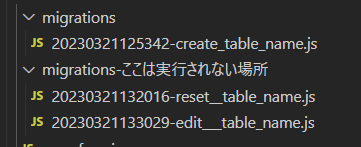Node.jsの「Sequelize」の「migration機能」でよく使うパターンまとめ(備忘録)
migration下準備
mysqlを触るのに最低限必要なやつインストール
npm i sequelize -D
npm i sequelize-cli -D
npm i mysql2 -D
今回追加でインストールしたもの
npm i path -D
npm i dayjs -D
Sequelizeの各ファイルのパス情報
各設定ファイルの保管パスを設定できます。
※プロジェクトのrootフォルダに設置
const path = require("path");
module.exports = {
config: path.resolve("sequelize", "config.json"),
"models-path": path.resolve("sequelize", "sequelize-models"),
"seeders-path": path.resolve("sequelize", "seeders"),
"migrations-path": path.resolve("sequelize", "migrations"),
};
Mysql 接続設定
{
"development": {
"host": "localhost",
"port": "3306",
"username": "root",
"password": "root",
"database": "test",
"dialect": "mysql",
"timezone": "+09:00",
"operatorsAliases": 0,
"logging": false
}
}
SequelizeのMigrationでよく使用する関数をまとめたもの
/*-------------------------------------------------
マイグレーションで使用する関数群
-------------------------------------------------*/
const ComFunc = {
/**
* マイグレーションファイルから下記のようにして使用する
* const con = ComFunc.GetConnection(queryInterface);
* const sql = 'select * from m_code';
* const ret = await con.query(sql, { raw: false });
*/
GetConnection: function (queryInterface) {
const Sequelize = require("sequelize");
const SequelizeConf = {
host: queryInterface.sequelize.options.host,
port: queryInterface.sequelize.options.port,
dialect: "mysql",
timezone: "+09:00",
logging: false, // ← 追記
dialectOptions: {
timezone: "+09:00",
dateStrings: true,
typeCast: function (field, next) {
if (field.type === "DATETIME") {
return field.string();
}
return next();
},
},
};
return new Sequelize(
queryInterface.sequelize.config.database,
queryInterface.sequelize.options.username,
queryInterface.sequelize.options.password,
SequelizeConf
);
},
IndexKey: {
Add: async function (queryInterface, tableName, setIndexList) {
const setIndexListCount = setIndexList.length;
for (let i = 0; i < setIndexListCount; i++) {
if (setIndexList[i].length === 0) continue;
const indexName = setIndexList[i][0] + "_index";
const indexList = [];
const setIndexListChildCount = setIndexList[i].length;
for (let j = 0; j < setIndexListChildCount; j++) {
if (setIndexList[i][j] !== "") {
indexList.push(setIndexList[i][j]);
}
}
await queryInterface.addIndex(tableName, indexList, {
name: indexName,
});
}
},
Remove: async function (queryInterface, tableName, setIndexList) {
const setIndexListCount = setIndexList.length;
for (let i = 0; i < setIndexListCount; i++) {
if (setIndexList[i].length === 0) continue;
const indexName = setIndexList[i][0] + "_index";
await queryInterface.removeIndex(tableName, indexName);
}
},
},
UniqueKey: {
Add: async function (queryInterface, tableName, setIndexList) {
const setIndexListCount = setIndexList.length;
for (let i = 0; i < setIndexListCount; i++) {
if (setIndexList[i].length === 0) continue;
const indexName = setIndexList[i][0] + "_uq_index";
const indexList = [];
const setIndexListChildCount = setIndexList[i].length;
for (let j = 0; j < setIndexListChildCount; j++) {
if (setIndexList[i][j] !== "") {
indexList.push(setIndexList[i][j]);
}
}
await queryInterface.addIndex(tableName, indexList, {
name: indexName,
unique: true,
});
}
},
Remove: async function (queryInterface, tableName, setIndexList) {
const setIndexListCount = setIndexList.length;
for (let i = 0; i < setIndexListCount; i++) {
if (setIndexList[i].length === 0) continue;
const indexName = setIndexList[i][0] + "_uq_index";
await queryInterface.removeIndex(tableName, indexName);
}
},
},
Column: {
Change: async function (queryInterface, tableName, scheme) {
const keys = Object.keys(scheme);
for (let i = 0; i < keys.length; i++) {
await queryInterface.changeColumn(tableName, keys[i], scheme[keys[i]]);
}
},
Add: async function (queryInterface, tableName, scheme) {
const keys = Object.keys(scheme);
for (let i = 0; i < keys.length; i++) {
await queryInterface.addColumn(tableName, keys[i], scheme[keys[i]]);
}
},
Remove: async function (queryInterface, tableName, scheme) {
const keys = Object.keys(scheme);
for (let i = 0; i < keys.length; i++) {
await queryInterface.removeColumn(tableName, keys[i]);
}
},
},
};
module.exports = ComFunc;
あとはSequelizeのコマンドでMigrationファイルを作って実行するだけ
Migration
Migration ファイルの作成コマンド
npx sequelize migration:generate --name create_table_name
--name 以降がmigrationのファイル名に付与される
Migration ファイル
実行したら以下のファイルが生成されます。(ファイル名は生成日に --name以降の文字列が付与される
'use strict';
/** @type {import('sequelize-cli').Migration} */
module.exports = {
async up (queryInterface, Sequelize) {
/**
* Add altering commands here.
*
* Example:
* await queryInterface.createTable('users', { id: Sequelize.INTEGER });
*/
},
async down (queryInterface, Sequelize) {
/**
* Add reverting commands here.
*
* Example:
* await queryInterface.dropTable('users');
*/
}
};
migrationファイルの準備ができたら以下コマンドでDBへ反映できる
npx sequelize db:migrate --env development
修正したいときで一つ前にmigrationを戻す時
npx sequelize db:migrate:undo --env development
全部戻す場合
npx sequelize db:migrate:undo:all --env development
Migration テーブル追加サンプル
/* eslint-disable */
const { DataTypes, QueryTypes } = require("sequelize");
const ComFunc = require("../com-func");
//--------------------------------------
const tableName = "table_name";
const tableComments = "tableComments";
/** @type {import('sequelize-cli').Migration} */
module.exports = {
async up(queryInterface, Sequelize) {
const columns = {
id: {
type: DataTypes.INTEGER.UNSIGNED,
allowNull: false,
autoIncrement: true,
primaryKey: true,
comment: "ID",
},
user_e_mail: {
type: DataTypes.STRING(200),
allowNull: false,
comment: "ユーザーE-Mail",
},
user_name: {
type: DataTypes.STRING(200),
allowNull: false,
comment: "ユーザー名",
},
obj: {
type: DataTypes.JSON,
allowNull: false,
comment: "obj",
},
//------------------
activate: {
type: DataTypes.TINYINT,
allowNull: true,
defaultValue: 1,
comment: "ユニーク制御フラグ",
},
//------------------
created_at: {
type: DataTypes.DATE(3), //ミリ秒
allowNull: false,
comment: "ミリ秒まで管理",
},
updated_at: {
type: DataTypes.DATE, //秒
allowNull: false,
comment: "秒まで管理",
},
date_only: {
type: DataTypes.DATEONLY, //日付のみ
allowNull: false,
comment: "日付のみ",
},
};
await queryInterface.createTable(tableName, columns, {
comment: tableComments,
collate: "utf8mb4_general_ci",
});
await ComFunc.IndexKey.Add(queryInterface, tableName, [
["user_name"],
]);
await ComFunc.UniqueKey.Add(queryInterface, tableName, [
["user_e_mail", "activate"],
]);
},
async down(queryInterface, Sequelize) {
await queryInterface.dropTable(tableName);
},
};
Migration テーブルへのデータ追加サンプル
※Seed機能を使わないケースなど
※定数管理テーブルなどはMigrationの方が運用上便利に感じたので
"use strict";
/* eslint-disable */
const ComFunc = require("../com-func");
const dayjs = require("dayjs");
//--------------------------------------
const tableName = "table_name";
//--------------------------------------
/** @type {import('sequelize-cli').Migration} */
module.exports = {
async up(queryInterface, Sequelize) {
await queryInterface.bulkDelete(tableName, null, {});
const con = ComFunc.GetConnection(queryInterface);
const sql = "ALTER TABLE `" + tableName + "` auto_increment = 1";
await con.query(sql, { raw: false });
const list = [
{
user_e_mail: "test1@example.com",
user_name: "test1",
obj: JSON.stringify({ message: "messsssseageeee" }),
activate: 1,
created_at: dayjs().format("YYYY-MM-DD HH:mm:ss.SSS"),
updated_at: dayjs().format("YYYY-MM-DD HH:mm:ss.SSS"),
date_only: dayjs().format("YYYY-MM-DD HH:mm:ss.SSS"),
},
];
await queryInterface.bulkInsert(tableName, list, {});
},
async down(queryInterface, Sequelize) {
await queryInterface.bulkDelete(tableName, null, {});
const con = ComFunc.GetConnection(queryInterface);
const sql = "ALTER TABLE `" + tableName + "` auto_increment = 1";
await con.query(sql, { raw: false });
const list = [];
if (list.length !== 0) {
await queryInterface.bulkInsert(tableName, list, {});
}
},
};
実行結果
Migration テーブルへのカラム編集サンプル
"use strict";
/* eslint-disable */
const { DataTypes, QueryTypes } = require("sequelize");
const ComFunc = require("../com-func");
//--------------------------------------
const tableName = "table_name";
/** @type {import('sequelize-cli').Migration} */
module.exports = {
async up(queryInterface, Sequelize) {
await ComFunc.IndexKey.Remove(queryInterface, tableName, [
["user_name"],
]);
const columns = {
note: {
type: DataTypes.STRING(200),
allowNull: false,
comment: "備考",
},
};
await ComFunc.Column.Add(queryInterface, tableName, columns);
await ComFunc.IndexKey.Add(queryInterface, tableName, [
["user_name", "note"],
]);
},
async down(queryInterface, Sequelize) {
//逆方向で実行すれば元通り。
await ComFunc.IndexKey.Remove(queryInterface, tableName, [
["user_name", "note"],
]);
const columns = {
note: {
type: DataTypes.STRING(200),
allowNull: false,
comment: "備考",
},
};
await ComFunc.Column.Remove(queryInterface, tableName, columns);
await ComFunc.IndexKey.Add(queryInterface, tableName, [
["user_name"],
]);
},
};
コピペで安全にmigrationを管理できるよう関数を考えては・・・いるつもり。
ただ、複雑な使い方はしていない。
なので詳しくは以下公式までどうぞ
一応 GitHubにサンプル上げてます
サンプルはマイグレーションファイルのフォルダを分けています。
npx sequelize db:migrate --env development
をすると「migrationsフォルダ」にあるmigrationファイルが全部実行されてしまうので・・・
フォルダを「migrations」へ移動すればDBへの反映ができるようになります。
TypeScriptでORMとしてSequelizeを使う例はこちら





